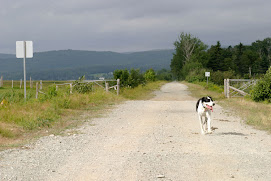RIght View:
“This new library is the community's gift to itself. Come enjoy what you have built!” -- Library Director Susan Flannery
By coincidence, the new Cambridge Main Library opened to the public on November 9, 2009, on the 20th anniversary of the fall of the Berlin Wall. I visited the library to get a copy of Animal Farm to commemorate both events.
Entering the new “Glass” building has a very high wow factor. You could set up a high wire act in the main floor space. In a word, spectacular.
The modern library emphasizes its role as social center as much as quiet reading room. Whenever I visit the Watertown Library teen center it’s full of chattering teens, and the Cambridge architects have provided many public gathering places. The spaces are gorgeous--provided they are used to their full potential. It’s now the challenge of the library staff to justify our state-of-the-art 100-seat theatre two stories below ground by filling it with frequent events.
I imagined I would claim a cozy nook where I could curl up, but if you want cozy, you’re better off in the H.H. Richardson-inspired “Stone” building or in one of the branch libraries. Perhaps our homes fulfill the need for cozy spaces; we’re no longer escaping crowded tenement living to the quiet of a library.
What about the library’s cost? The final bill came in above $90 million or $900 a square foot for the 100,000 square foot building. Somehow the foxes guarding the henhouse allowed a 50% cost overrun above the 2006 estimate of $60 million. Is $900/sq. ft. expensive? Yes, it’s four and half times the average cost (around $200/sq. ft.) for college buildings in Boston in 2009, according to R.S. Means Construction Data.
The Chronicle quotes Councilor Ken Reeves, “it’s better than Newton’s library, which was the goal.” The Newton Free Library was completed in 1991 for $15.3 million, or $168 a square foot for its 91,000 square feet. Prices certainly have gone up since 1991, but 535 percent? Cambridge taxpayers should expect a better library for the money we spent, but is it better? I’m not sure how one would judge such a thing. Cambridge loses on one criterion: Newton has 578,000 volumes, Cambridge a mere 177,000. You do in fact sense this on walking in—great space, but where do they keep the books?
Was there ever any discussion of whether green LEED certification was worth the added cost? Using paint and non-toxic glues that don’t outgas volatile organic compounds is certainly worth the marginally higher cost for the materials. But did we spend money on non-essential items simply to be able to claim that we have a green building?
And even if the price is high, can we afford it? The price tag works out to $900 per Cambridge resident. For a family of four, that’s $3,600, or $180 a year over 20 years. Cambridge businesses will pick up part of the tab, and the State of Massachusetts kicked in $10 million. $180 a year isn’t enough by itself to bankrupt anyone. But then there’s that $120 million renovation of Rindge and Latin on the horizon. And Other Post Employment Benefits. Etc. Maybe it would have been wiser to buy the Ford Taurus, but the City Council bought the shiny new Mercedes, so we might as well take it for a drive.
We also have to pay to operate the place. The Main Branch budget is $5.5 million for FY2010, or $55 for every Cambridge resident. Not a bad deal, even for a small government conservative. Still, it’s worth pointing out that since 2008, the library budget has increased by $1.3 million, a rise of 32%. The increase is entirely in the “library-as-social-center” areas; while expenditures for Reference and Circulation (i.e., books) have remained flat, “Public Services” is up 90%, “Supportive Services” up 105% and “Computer tech services,” up 100%.
Which brings me to Animal Farm. The CPL has an amazing service that allows you to download audiobooks over the Internet, but after an hour on the Library website I had not downloaded a byte of Animal Farm. I went to the Reference desk for help where they told me they didn’t support Macintosh computers (not accurate). I was then told I was using the wrong browser (also incorrect—the wireless internet was down). In the end I gave up on the public option and paid $7.49 to Audiobooks. Did I mention—what a remarkable book!
skip to main |
skip to sidebar


Culture War Dispatches
from a Progressive People's Republic
Daisy takes a walk

"I detest the notion of a new dawn in which homo sapiens would live in harmony. The hope this Utopia engenders has justified the bloodiest exterminations in history." --Francois Bizet, Khmer Rouge survivor
"Of all tyrannies, a tyranny sincerely exercised for the good of its victims may be the most oppressive." --C.S. Lewis
Daisy
